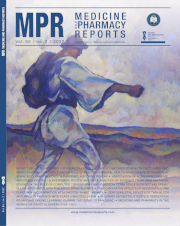Antimicrobial efficacy of grape seed extract in terminating the ramifications of plaque microorganisms: a randomized control study
DOI:
https://doi.org/10.15386/mpr-1978Keywords:
grape seed extract, colony forming unit, plaque, randomized control study, mouthwashAbstract
inhibiting interstitial and extracellular collagenase, thus having the potential to reduce the progression of periodontitis. Here we compare and evaluate the aerobic and anaerobic microorganism’s CFUs (colony forming units) in plaque samples of Group A, Group B, Group C and severity of periodontal disease on day 0 and 7.
Method. Forty-five subjects in age range 18-30 years were selected among undergraduate students and randomly divided into Group A: 15, 2% grape seed extract mouthwash (GSE), Group B: 15, 0.2% chlorhexidine mouthwash (CHX) and Group C: 15, distilled water (control). The supragingival plaque was collected into transport media. Kruskal Wallis test followed by Mann Whitney test was used to compare the mean CFUs [x103] of microorganisms and severity of periodontal disease was compared, by clinical parameters among all groups on day 0 and 7.
Results. There was a significant difference concerning mean scores of all clinical parameters [P<0.001] and mean CFUs of microorganisms between 3 study groups [P=0.005] at 7 days post-intervention period. Intragroup comparison, mean scores were significantly reduced on day 7 as compared to day 0 at [P<0.001] in Group A and B, but no significant difference was noted with Group C.
Conclusion. Intervention with GSE mouthwash showed a positive effect on reducing CFUs in the plaque when compared with the control group. GSE group also showed similar results in reducing CFUs in plaque when compared to CHX group, thereby demonstrating the agent’s antimicrobial efficacy, therapeutic effect and its potential usefulness in controlling plaque and periodontal diseases.
Downloads
Published
How to Cite
Issue
Section
License
The authors are required to transfer the copyright of the published paper to the journal. This is done by agreeing to sign the Copyright Assignment Form. Whenever the case, authors are also required to send permissions to reproduce material (such as illustrations) from the copyright holder.

The papers published in the journal are licensed under a Creative Commons Attribution-NonCommercial-NoDerivatives 4.0 International License.

